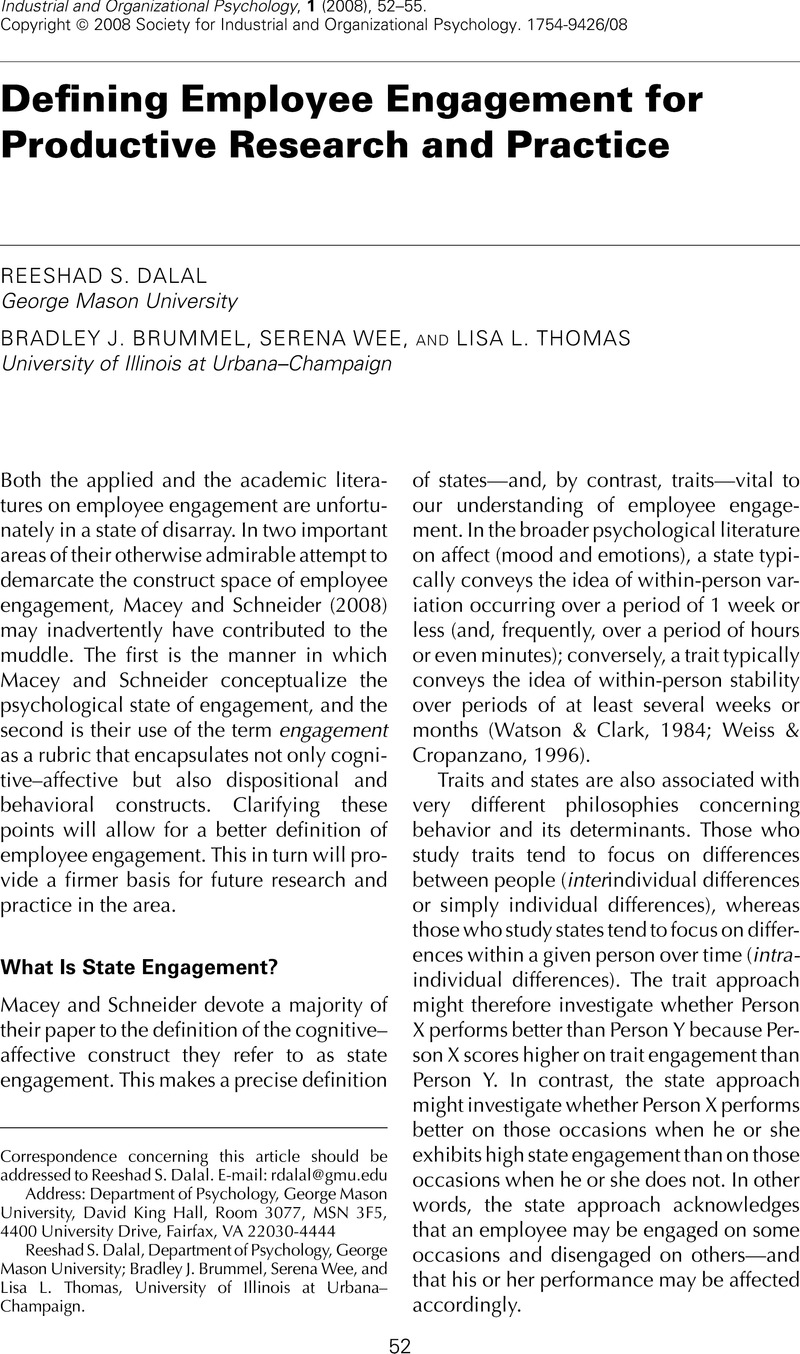Crossref Citations
This article has been cited by the following publications. This list is generated based on data provided by Crossref.
Macey, William H.
and
Schneider, Benjamin
2008.
Engaged in Engagement: We Are Delighted We Did It.
Industrial and Organizational Psychology,
Vol. 1,
Issue. 1,
p.
76.
Zigarmi, Drea
Nimon, Kim
Houson, Dobie
Witt, David
and
Diehl, Jim
2009.
Beyond Engagement:Toward a Framework and Operational Definition for Employee Work Passion.
Human Resource Development Review,
Vol. 8,
Issue. 3,
p.
300.
Kühnel, Jana
Sonnentag, Sabine
and
Westman, Mina
2009.
Does work engagement increase after a short respite? The role of job involvement as a double‐edged sword.
Journal of Occupational and Organizational Psychology,
Vol. 82,
Issue. 3,
p.
575.
Walumbwa, Fred O.
Wang, Peng
Wang, Hui
Schaubroeck, John
and
Avolio, Bruce J.
2010.
RETRACTED: Psychological processes linking authentic leadership to follower behaviors.
The Leadership Quarterly,
Vol. 21,
Issue. 5,
p.
901.
Gruman, Jamie A.
and
Saks, Alan M.
2011.
Performance management and employee engagement.
Human Resource Management Review,
Vol. 21,
Issue. 2,
p.
123.
CHRISTIAN, MICHAEL S.
GARZA, ADELA S.
and
SLAUGHTER, JEREL E.
2011.
WORK ENGAGEMENT: A QUANTITATIVE REVIEW AND TEST OF ITS RELATIONS WITH TASK AND CONTEXTUAL PERFORMANCE.
Personnel Psychology,
Vol. 64,
Issue. 1,
p.
89.
Shuck, Brad
2011.
Integrative Literature Review: Four Emerging Perspectives of Employee Engagement: An Integrative Literature Review.
Human Resource Development Review,
Vol. 10,
Issue. 3,
p.
304.
Kühnel, Jana
Sonnentag, Sabine
and
Bledow, Ronald
2012.
Resources and time pressure as day‐level antecedents of work engagement.
Journal of Occupational and Organizational Psychology,
Vol. 85,
Issue. 1,
p.
181.
Dalal, Reeshad S.
2012.
Handbook of Psychology, Second Edition.
Judge, Timothy A.
Hulin, Charles L.
and
Dalal, Reeshad S.
2012.
The Oxford Handbook of Organizational Psychology, Volume 1.
p.
496.
VOLPONE, SABRINA D.
AVERY, DEREK R.
and
McKAY, PATRICK F.
2012.
Linkages Between Racioethnicity, Appraisal Reactions, and Employee Engagement.
Journal of Applied Social Psychology,
Vol. 42,
Issue. 1,
p.
252.
Dalal, Reeshad S.
Baysinger, Michael
Brummel, Bradley J.
and
LeBreton, James M.
2012.
The Relative Importance of Employee Engagement, Other Job Attitudes, and Trait Affect as Predictors of Job Performance.
Journal of Applied Social Psychology,
Vol. 42,
Issue. S1,
Stumpf, Stephen A.
Tymon,, Walter G.
and
van Dam, Nick H.M.
2013.
Felt and behavioral engagement in workgroups of professionals.
Journal of Vocational Behavior,
Vol. 83,
Issue. 3,
p.
255.
Reissner, Stefanie
and
Pagan, Victoria
2013.
Generating employee engagement in a public–private partnership: management communication activities and employee experiences.
The International Journal of Human Resource Management,
Vol. 24,
Issue. 14,
p.
2741.
Moodie, Scott
Dolan, Simon
and
Burke, Roland
2014.
Exploring the causes, symptoms and health consequences of joint and inverse states of work engagement and burnout.
Management Research: The Journal of the Iberoamerican Academy of Management,
Vol. 12,
Issue. 1,
p.
4.
Dalal, Reeshad S.
Bhave, Devasheesh P.
and
Fiset, John
2014.
Within-Person Variability in Job Performance.
Journal of Management,
Vol. 40,
Issue. 5,
p.
1396.
Leon, Matthew R.
Halbesleben, Jonathon R.B.
and
Paustian-Underdahl, Samantha C.
2015.
A dialectical perspective on burnout and engagement.
Burnout Research,
Vol. 2,
Issue. 2-3,
p.
87.
Brummel, Bradley J.
and
Parker, Kelsey N.
2015.
Obligation and Entitlement in Society and the Workplace.
Applied Psychology,
Vol. 64,
Issue. 1,
p.
127.
Keating, Lauren A.
and
Heslin, Peter A.
2015.
The potential role of mindsets in unleashing employee engagement.
Human Resource Management Review,
Vol. 25,
Issue. 4,
p.
329.
Griffin, Barbara
2015.
Collective norms of engagement link to individual engagement.
Journal of Managerial Psychology,
Vol. 30,
Issue. 7,
p.
847.





